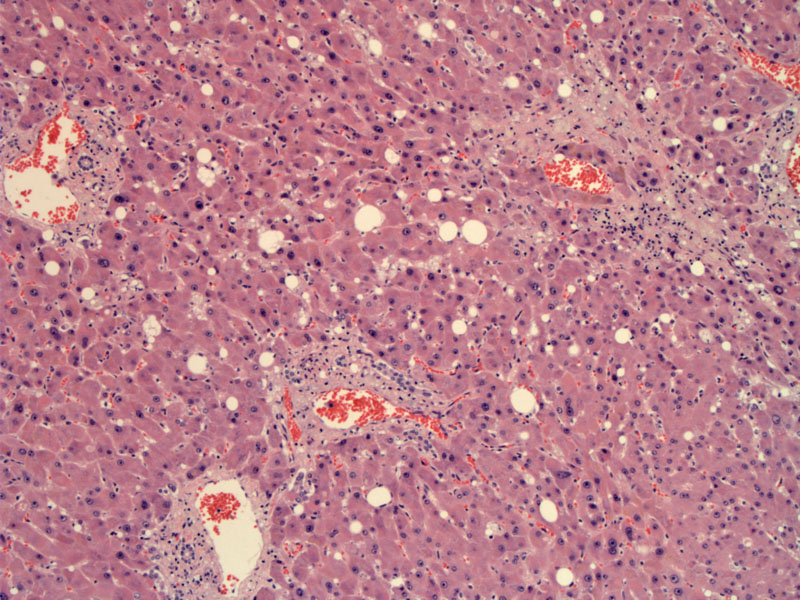

From low power, nonspecific liver damage is seen with steatosis and mild inflammation.
Hyperplasia and hypertrophy of perisinusoidal hepatic stellate cells and perisinusoidal fibrosis (difficult to detect at this power) are the result of hepatic storage of excess vitamin A. Although not applicable to this case, concomitant alcohol use can potentiate the hepatotoxicity of vitamin A.
A higher power, you can clearly see hepatic stellate cells (Ito cells) filled with lipid droplets containing vitamin A; the cell nucleus can look a bit scalloped as it is compressed by the fat droplets.
In the United States, about 35-50% of adults ingest vitamin and mineral supplements, which often contain vitamin A (Eledrisi). As a fat-soluble vitamin, excess of vitamin A is stored in fat and thus more likely to lead to toxicity. By contrast, excess of water-soluable vitamins is merely excreted in urine.
Retinol is the main compound with vitamin A function and is principally stored as retinyl esters in hepatic stellate cells (aka Ito cells). Hepatic stellate cells are located in the space of Disse and function as storage cells for lipids and vitamin A. They can elaborate hepatocyte growth factor and collagen, and thus play a key role in liver fibrogenesis and fibrosis (Mills).
Vitamin A hepatotoxicity is rare, with a spectrum of liver manifestation rangubg from minimal changes, to fibrosis and cirrhosis. Excess of vitamin A can activate the hepatic stellate cells, leading to hypertrophy and hyperplasia of these cells, as well as inducing fibrosis (Scheuer, Nollevaux).
Usually due to prolonged ingestion of vitamin A. Presents with fatigue and weakness, anorexia, constipation, brittle nails, scaly dry rough skin, hair loss, and cortical bone thickness. Patients may also develop portal hypertension and ascites.
Preventative measures include limiting vitamin doses to 3000 to 4000 IU. There is a dose dependent relationship between dosage and severity of liver fibrosis (Nollevaux).
Hypervitaminosis leads to activation of hepatic stellate (Ito) cells, which store lipid and vitamin A.
Activated Ito cells elaborate extracellular matrix components (i.e. collagen) and lead to perisinuosoidal fibrosis (and eventually cirrhosis).
Mills, S. Histology for Pathologists. 3rd Ed. Philadelphia, PA: Lippincott, Williams & Wilkins; 2007: 691-2.
Nollevaux MC, Guiot Y, Horsmans Y et al. Hypervitaminosis A-induced liver fibrosis: stellate cell activation and daily dose consumption. Liver Int. 2006 Mar;26(2):182-6.
Scheuer PJ, Lefkowitch JH. Liver Biopsy Interpretation 7th Ed. Philadelphia, PA: Elsevier; 2006: 134-5.